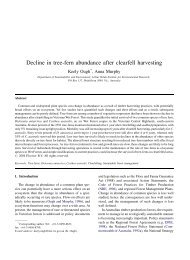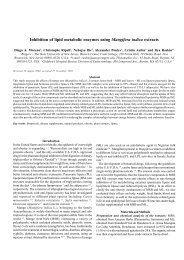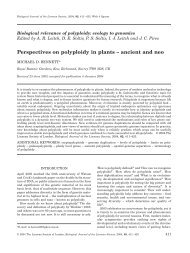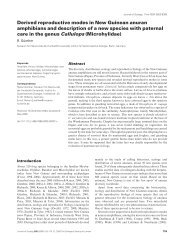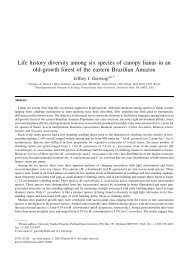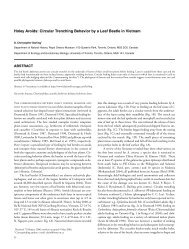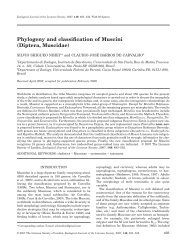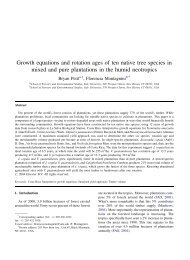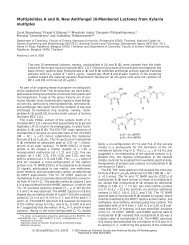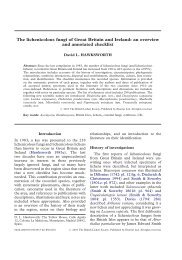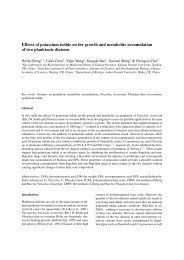Frequency of Cyanogenesis in Tropical Rainforests of Far North ...
Frequency of Cyanogenesis in Tropical Rainforests of Far North ...
Frequency of Cyanogenesis in Tropical Rainforests of Far North ...
You also want an ePaper? Increase the reach of your titles
YUMPU automatically turns print PDFs into web optimized ePapers that Google loves.
California, Davis, CA, USA, pers. comm.). The <strong>in</strong>consistent<br />
f<strong>in</strong>d<strong>in</strong>gs by Conn are probably the result <strong>of</strong> us<strong>in</strong>g dried<br />
herbarium material.<br />
<strong>Cyanogenesis</strong> is considered especially common <strong>in</strong><br />
the Proteaceae (Swenson et al., 1989; Lechtenberg and<br />
Nahrstedt, 1999), known <strong>in</strong> a range <strong>of</strong> genera, but particularly<br />
<strong>in</strong> Grevillea and Hakea spp. In Australia, cyanogenic<br />
members <strong>of</strong> the Proteaceae have been implicated <strong>in</strong><br />
stock poison<strong>in</strong>g (Gardner and Bennetts, 1956). Based on the<br />
reports <strong>of</strong> Gibbs (1974) and Tjon Sie Fat (1979a), and the<br />
study <strong>of</strong> Swenson et al. (1989) who found 44 <strong>of</strong> 155 proteaceous<br />
species tested to be cyanogenic, cyanogenesis<br />
is most widespread <strong>in</strong> the subfamily Grevilleoideae. For<br />
example, cyanogenesis has been reported <strong>in</strong> the genera<br />
Stenocarpus, Lomatia, Helicia, Xylomelum, Telopea,<br />
Macadamia, Hicksbeachia, Lambertia, Grevillea and<br />
Xylomelum (Petrie, 1912; Smith and White, 1918; Hurst,<br />
1942; Gardner and Bennetts, 1956; Gibbs, 1974; Swenson<br />
et al., 1989; Lamont, 1993; E. E. Conn, University <strong>of</strong><br />
California, Davis, CA, USA, pers. comm.), all <strong>of</strong> which<br />
are <strong>in</strong> the Grevilloiedeae (Hoot and Douglas, 1998). Consistent<br />
with this pattern, the cyanogenic genera reported<br />
here are all <strong>in</strong> the subfamily Grevilleoideae; Cardwellia<br />
<strong>in</strong> the subtribe Cardwelli<strong>in</strong>ae (tribe Knightieae), Opisthiolepis<br />
<strong>in</strong> the subtribe Buck<strong>in</strong>ghami<strong>in</strong>ae (tribe Embothrieae),<br />
and Helicia <strong>in</strong> the subtribe Helici<strong>in</strong>ae (tribe Heliceae). In<br />
contrast, there are only a few reports <strong>of</strong> cyanogenesis with<strong>in</strong><br />
the Proteoideae subfamily; cyanogenesis was only reported<br />
<strong>in</strong> s<strong>in</strong>gle species <strong>of</strong> Conospermum, Petrophile and Protea<br />
(Gibbs, 1974; Swenson et al., 1989; E. E. Conn, University<br />
<strong>of</strong> California, Davis, CA, USA, pers. comm.).<br />
The cyanogenic constituents, which have been identified<br />
<strong>in</strong> comparatively few species, appear to be biogenetically<br />
derived from tyros<strong>in</strong>e. Swenson et al. (1989) identified<br />
the cyanogenic glycosides <strong>in</strong> eight species; leaves and<br />
flowers <strong>of</strong> several Hakea, Leucadendron, Grevillea<br />
and Macadamia species were found to conta<strong>in</strong> dhurr<strong>in</strong><br />
and proteac<strong>in</strong> (see also Plouvier, 1964; Young and<br />
Hamilton, 1966). In this regard, the identity <strong>of</strong> the cyanogenic<br />
constituent <strong>in</strong> the monospecific genera <strong>in</strong> particular<br />
would be <strong>in</strong>terest<strong>in</strong>g.<br />
Prunus turneriana (F.M.Bailey) Kalkman (Rosaceae)<br />
<strong>Cyanogenesis</strong> is widespread with<strong>in</strong> Rosaceae (Hegnauer,<br />
1990), and has been much studied <strong>in</strong> the subfamily<br />
Prunoideae <strong>in</strong> particular, as it conta<strong>in</strong>s many cyanogenic<br />
cultivated species [e.g. Prunus domestica L. (plum);<br />
Armeniaca vulgaris Lam. (apricot)]. Cyanogenic Rosaceae<br />
(<strong>in</strong> particular Prunus spp.) are also a common source <strong>of</strong><br />
poison<strong>in</strong>g <strong>in</strong> domestic animals (e.g. Poulton, 1983;<br />
Schuster and James, 1988). Prunus turneriana is one <strong>of</strong><br />
only two Prunus species native to Australia and is a late<br />
successional canopy tree species <strong>in</strong> the lowland and upland<br />
ra<strong>in</strong>forests <strong>of</strong> far north Queensland, Australia. The fruits <strong>of</strong><br />
this canopy species are known to be toxic, yet are also eaten<br />
by cassowaries, fruit pigeons, Herbert river r<strong>in</strong>gtail possums<br />
and musky-rat kangaroos (Cooper and Cooper, 1994).<br />
The flesh <strong>of</strong> the fruit was used raw by the Ngadjonji<br />
people—the orig<strong>in</strong>al <strong>in</strong>habitants <strong>of</strong> the ra<strong>in</strong>forests on<br />
the Atherton Tablelands, north Queensland—for treat<strong>in</strong>g<br />
toothache, while the toxic kernels were processed for a<br />
starchy food (Huxley, 2003). Despite its common name<br />
‘Almond bark’ and phytochemical surveys <strong>of</strong> Australian<br />
ra<strong>in</strong>forest species (e.g. Webb, 1949), cyanogenesis <strong>in</strong> P.<br />
turneriana had not previously been reported. Cyanogenic<br />
glycosides were found to be distributed throughout all tissues<br />
and, consistent with other species <strong>in</strong> the Rosaceae, are<br />
biosynthetically derived from the am<strong>in</strong>o acid phenylalan<strong>in</strong>e<br />
(Møller and Seigler, 1999). Prunas<strong>in</strong> was identified as the<br />
major cyanogen <strong>in</strong> leaf, stem, root and seed tissues <strong>of</strong><br />
P. turneriana, and amygdal<strong>in</strong> was restricted to the seed.<br />
What was unusual about P. turneriana was the presence<br />
<strong>of</strong> significant amounts <strong>of</strong> the (R)-prunas<strong>in</strong> epimer, (S)-<br />
sambunigr<strong>in</strong>, <strong>in</strong> leaf, stem and seed tissue, whereas root<br />
tissue conta<strong>in</strong>ed only prunas<strong>in</strong>. Refer to Miller et al.<br />
(2004) for the detailed characterization <strong>of</strong> cyanogenesis<br />
<strong>in</strong> P. turneriana.<br />
Brombya platynema F.Muell. (Rutaceae)<br />
This is the first report <strong>of</strong> cyanogenesis <strong>in</strong> the genus<br />
Brombya, which is a genus <strong>of</strong> 1–2 species endemic to<br />
Australia (Hyland et al., 2003). Brombya platynema is<br />
endemic to north east Queensland where it occurs as an<br />
understorey tree <strong>in</strong> well-developed forest (from sea level<br />
to 1100 m a.s.l.) (Hyland et al., 2003). The family (150<br />
genera, 1500 species) <strong>in</strong>cludes many strongly scented<br />
shrubs and trees, and rutaceous species are known for<br />
their terpenoids and alkaloids (Price, 1963; Gibbs, 1974;<br />
Everist, 1981). <strong>Cyanogenesis</strong> is rare <strong>in</strong> Rutaceae, and has<br />
only been reported <strong>in</strong> Boronia bip<strong>in</strong>nate L<strong>in</strong>dl. (leaves;<br />
Rosenthaler, 1919), Zieria spp. (Hurst, 1942; Gibbs, 1974;<br />
Fikenscher and Hegnauer, 1977), Zanthoxylum fagara<br />
(Adsersen et al., 1988) and Loureira coch<strong>in</strong>ch<strong>in</strong>ensis<br />
Meissa (Gibbs, 1974). Even with<strong>in</strong> the order Rutales,<br />
cyanogenesis is rare, with only a few additional def<strong>in</strong>itive<br />
reports <strong>of</strong> cyanogenesis <strong>in</strong> the Tremandraceae family<br />
(Gibbs, 1974). The phenylalan<strong>in</strong>e-derived cyanogenic glycosides<br />
prunas<strong>in</strong>/sambunigr<strong>in</strong> and zier<strong>in</strong> have been isolated<br />
from leaves <strong>of</strong> two Zieria spp. (F<strong>in</strong>nemore and Cooper,<br />
1936; Fikenscher and Hegnauer, 1977). The rare metahydroxylated<br />
cyanogenic glycoside holocal<strong>in</strong> was recently<br />
identified as the pr<strong>in</strong>cipal cyanogen <strong>in</strong> leaves <strong>of</strong><br />
B. platynema; traces <strong>of</strong> prunas<strong>in</strong> and amygdal<strong>in</strong> were<br />
also detected (Miller et al., 2006b). These data suggest<br />
the possibility that species <strong>in</strong> this family have cyanogenic<br />
glycosides biosynthetically derived from the am<strong>in</strong>o acid<br />
phenylalan<strong>in</strong>e.<br />
Mischocarpus grandissimus (F.Muell.) Radlk. and<br />
Mischocarpus exangulatus (F.Muell.) Radlk. (Sap<strong>in</strong>daceae)<br />
Two <strong>of</strong> the four species <strong>of</strong> Mischocarpus tested <strong>in</strong> this<br />
study were found to be cyanogenic—M. grandissimus and<br />
M. exangulatus—represent<strong>in</strong>g the first reports <strong>of</strong> cyanogenesis<br />
for the genus. Mischocarpus is a genus <strong>of</strong> 15 species<br />
found <strong>in</strong> Asia, Malesia and Australia; n<strong>in</strong>e species occur<br />
naturally <strong>in</strong> Australia (Hyland et al., 2003). Both species<br />
are endemic to Queensland; M. grandissimus is restricted to<br />
north east Queensland, while M. exangulatus is also found<br />
on the Cape York Pen<strong>in</strong>sula, Queensland. Mischocarpus



